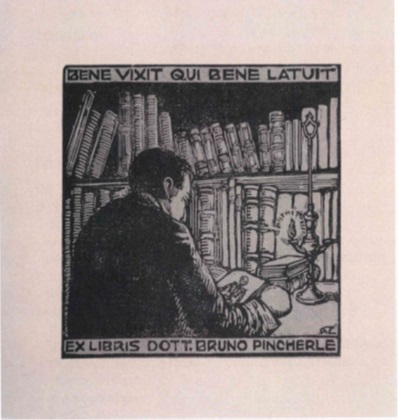Bruno Pincherle Book collection
Bibliographic material obtained from the family of Bruno Pincherle (1903-1968), pediatrician, politician, caricaturist, bibliophile and scholar of Stendhal.
History and education
The Pincherle book legacy, preserved at the Central Library of Medicine, is a perfect combination of Pincherle’s love of books and his medical-scientific interests. Pincherle was, in fact, a real enthusiast of medicine and his library reveals both his personality as a doctor and the original contribution made towards the development of the history of Italian medicine in the 20th century.
We do not know if the establishment of the Collection was more down to his clear interest in antique books or to his study requirements. What we do know is that the genesis of the Collection can be dated to late 1921, when Pincherle enrolled with the Faculty of Medicine of the Royal Institute of Further Education of Florence. We also know that the medical historian Arturo Castiglioni and the doctor Vittorio Pavia played an important role in forming his book collection. Indeed, Arturo Castiglioni directed Pincherle towards studying medicine and gave him his first books on the subject. The Collection features many testimonials of these gifts in handwritten notes or other marks referring to the fact that the volumes were originally owned by Castiglioni. Instead, at his death in 1940, Vittorio Pavia left Pincherle his books on medicine by way of inheritance.
The collection, which after Pincherle’s death was kept by his brother Gino, until he died, was donated by the latter’s heirs, Pincherle’s nephew Renzo and nieces Valentina and Nicoletta Goldschmidt, to the University of Trieste and accepted in 1985 by Giuseppe Enzmann, who was the Director, at the time, of the Central Library of Medicine. The deed of donation was signed on 06 October 1986 for 3 groups of books, defined as “a”, “b” and “c”, worth an estimated total of 79,742,800 Italian lira. Group “a” was transferred to the University of Trieste with a series of contractual constraints, forming the “Bruno Pincherle History of Medicine Collection”. Instead, as sections “b” and “c” were free from constraints, they were directly included in the Library’s general assets.
In order to safeguard the collection and monitor respect for the contractual constraints, a committee of guarantors was established, comprising four trusted members designated by the heirs. Indeed, the committee was formed by: Francesco Alzetta, who had been a friend of Bruno Pincherle, Gianfranco Grechi, librarian of the municipal library Sormani of Milan (to which Pincherle’s Stendhal collection had previously been donated), Elvio Guagnini, full professor of Italian literature at the University of Trieste, and the Director of the Library of Medicine, Giuseppe Enzmann.
The valuable collection implemented the historic part of the Library’s assets and was initially placed at the old site of Via Vasari, near Maggiore Hospital. In 2006, it was transferred to the new site of the Central Library of Medicine in Cattinara, where it is still held today.
The Collection is described in three separate catalogues.
The first was published in the press in 1991 and regards all the books from the 16th to the 19th century, available for consultation at the Central Library of Medicine and, amongst these, also the volumes already held by Pincherle. The second, on the other hand, is the on-line catalogue of the University of Trieste libraries (Bibliounits). Finally, the third is the digital archive Openstarts, containing the scans of 299 volumes of the legacy (https://www.openstarts.units.it/handle/10077/13203).
The volumes, however, were donated without any accompanying documents clarifying how they had been collected over the years. We do not know what criteria was applied in acquiring them. It should also be pointed out that the current Collection is a subsequent selection of Pincherle’s most important volumes of the history of medicine.
The Collection comprises a considerable number of volumes (around 1500) and specifically:
- 26 from the 16th century
- 55 works from the 1600s
- 228 from the 1700s
- 218 from the 1800s
- 619 from the 1900s
- 6 manuscripts after the introduction of printing and some miscellaneous volumes holding writings by Bruno Pincherle.
The Collection is of medical texts covering various subject matters with a specific focus on paediatrics, gynaecology and obstetrics. The Collection is mainly made up of modern books but does also contain a valuable set of antique editions ranging from the 16th century to 1830. There are also some manuscripts of medical interest that can be dated to between the 17th and 18th centuries and a twentieth century prescription pad, again handwritten. The Collection is completed by 6 printed miscellaneous items containing scientific works and works on the history of medicine. There are also some antique book catalogues.
Important titles
The Pincherle donation is a collection of considerable bibliographic interest and has thus been featured in various exhibitions. The texts are important both due to their rarity and their significant scientific and cultural value. The volumes are also often correlated with magnificent illustrations, creating a perfect combination of graphic art and medical-scientific documents.
The exhibitions focussed on the Collection include: L’arte di Ippocrate. Libri di medicina dal 1500 al 1800 (curated by Alessandro Rinaldi, Euro Ponte, Claudio Bevilacqua and Diana De Rosa) and “Il dottor Pincherle: la vita, le passioni e l’impegno civile di un uomo libero” (curated by the Cizerouno Association of Trieste).
The are several volumes that should be considered as particularly significant. Note, for example, “Questionum medico-legalium” (Frankfurt, 1666) by Paolo Zacchia, doctor to Pope Innocent X and court doctor for the Pontifical State, considered to be the very first treaty on forensic medicine. “Trattato delle malattie dei bambini” (“The Diseases of Children and Their Remedies”) by Nils Rosen von Rosenstein (Imperial Monastero di S. Ambrogio Maggiore, Milan 1780), is also worthy of special mention, considered to be the first textbook in the history of modern paediatric medicine.
List of documents in the Bruno Pincherle Collection
Modern bibliographical material(published after 1830)
Ancient bibliographical material(published before 1831)
Scans of 300 antique volumes

